This post may contain affiliate links at no additional cost to you. As an Amazon Associate I earn from qualifying purchases. Click to view our full disclosure.
What's inside
Welcome to the only guide on at-home back workouts you’ll ever need.
Have you been training from home and noticing that your back isn’t quite getting the growth you want?
You may miss the feeling of your favorite machine barbell or machine. Is it even possible to build a big back at home? Should you just pack it in and head back to the gym?
Let me tell you, it’s not always easy, but it can be done!
As a personal trainer, I make sure my clients know that it doesn’t matter where you are or what equipment you have. It just takes some professional knowledge and a little creativity.
Today, I am going to take you through the ultimate at-home back workout guide. We’ll cover the 28 best back exercises and workouts to do with bodyweight, bands, kettlebells, and dumbbells.
Plus, we’ll go over the drawbacks of having a weak back and the best professional tips to help you truly transform.
Let’s jump in.
Anatomy of the Back Muscles
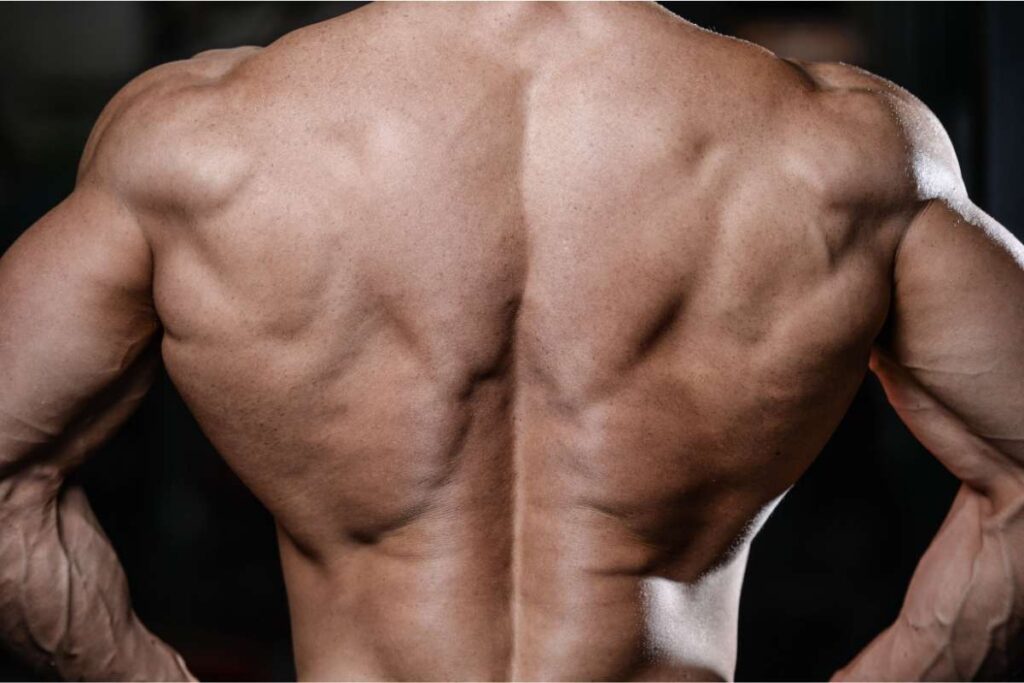
First, let’s go through the anatomy of the back. This will help you get a clear understanding of the target muscles, the action they perform, and exercise required to make them grow.
| Muscle | Action | Exercise |
| Trapezius | Upper Rotate Scapula, Extend Neck, Depress Scapula, Scapula Retraction, | Face Pull, Rows, Pull-Ups |
| Lats | Shoulder Adduction, Shoulder Extension | Pullovers, Rows, Pull-Ups |
| Rhomboids | Scapula Retraction, Scapula Elevation, Scapula Rotation | Rows, Face Pulls, Pull Ups |
Main Benefits of Exercising Your Back at Home
Related: Top 10 Middle Back Exercises
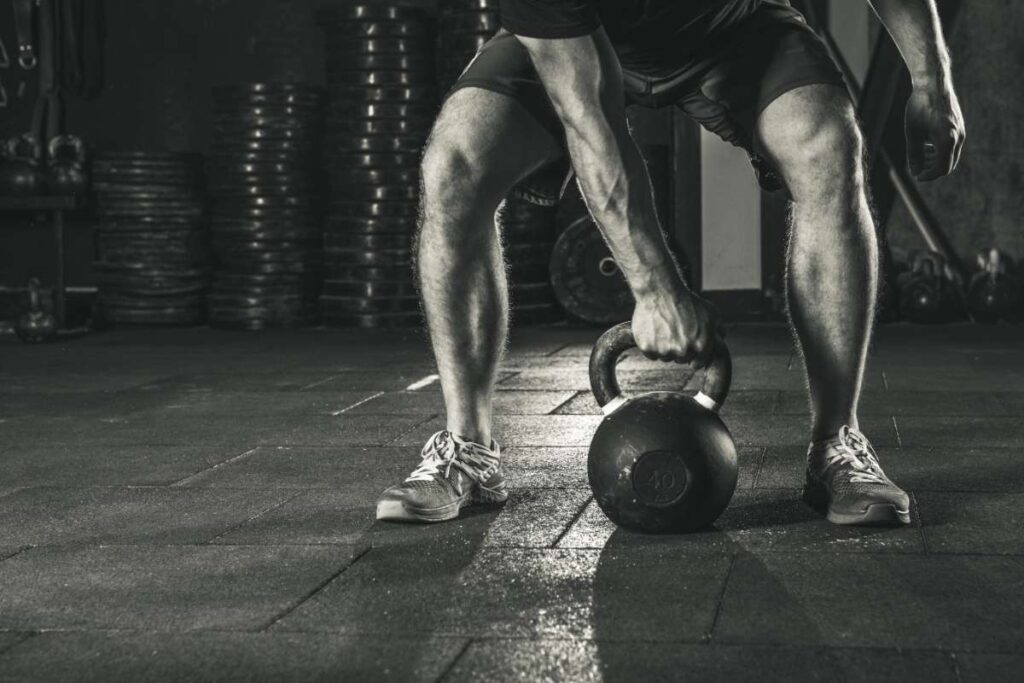
Chances are, you are missing the machine at the gym that seemed to give you effortless gains.
For this reason, I want you to explore the range of benefits that come from training back at home. Who knows? You might even shift your perspective and find this is the best way to train your back.
Time Efficient
Performing an at home back workout can be an incredible time-saver.
While most people are struggling to get out of the office, battling through traffic to get to the gym, you are just stepping outside (or inside) to your own private gym.
This dramatically cuts the time required to train each day while increasing your chances of remaining consistent.
Not Waiting for Machines
Let’s face it, waiting for equipment is possibly the most frustrating thing about going to the gym.
Standing there waiting for your next exercise is enough to break your rhythm and ruin your focus.
Performing an at home back workout means you’ll never be interrupted. Here, you can effortlessly jump from exercise to exercise, building your pump with laser-sharp focus.
Heck, you can even perform a five-exercise superset.
This is the ideal situation to create some epic back workouts that truly transform your back.
Save Money
Obviously, training your back at home is a great way to save money.
Now, I know what you are thinking. Yes, you will still have to buy some equipment. But I assure you that you can do it at a fraction of the cost of gyms, trainers, and or even home machines.
Best of all, once you buy it, there will be no ongoing payments, no maintenance fees, and nobody else’s sweat.
Full-Body Workout
When you begin training back at home, you will begin to notice how many of the exercises you perform feel like a full-body workout.
This is because – unlike the gym – you will not always have a bench or machine on hand to support your weight.
You will have to squat, plank, and brace your own bodyweight to stay stable while you hammer away toward bigger lats.
With exercises such as kettlebell deadlifts, renegade rows, pull-ups, and pullovers, you will not only be carving out a strong muscular back, but nailing a complete body workout.
Increase Mass

Doing an at home workout for back is an awesome way to build a bigger back.
Research suggests that performing sets of eight to 12 repetitions at 60%-80% of your one repetition maximum (1RM) is optimal for promoting muscle growth.
This can be easily done with a bodyweight, dumbbells, kettlebells, and bands, which can all be combined to create some incredible back transforming workouts.
Improve Strength
Naturally, we want to build back strength.
At first glance, the use of dumbbells may seem a little light compared to your barbell set up at the gym.
However, the challenge that comes with performing similar movements with kettlebells and dumbbells at home can really have a massive impact on strength.
Studies indicate that performing sets of one to five reps at 80%-100% of your 1RM is required to promote strength gains.
Working out within these guidelines will give you the strength gains that really challenge your entire body. In a bit, I’ll tell you exactly what exercises to do and share some sample programs.
For now, let’s focus on why you really need to pay attention to your back muscles.
Drawbacks of Weak Back Muscles
Related: 10 Tips For Building A Well-Defined Back
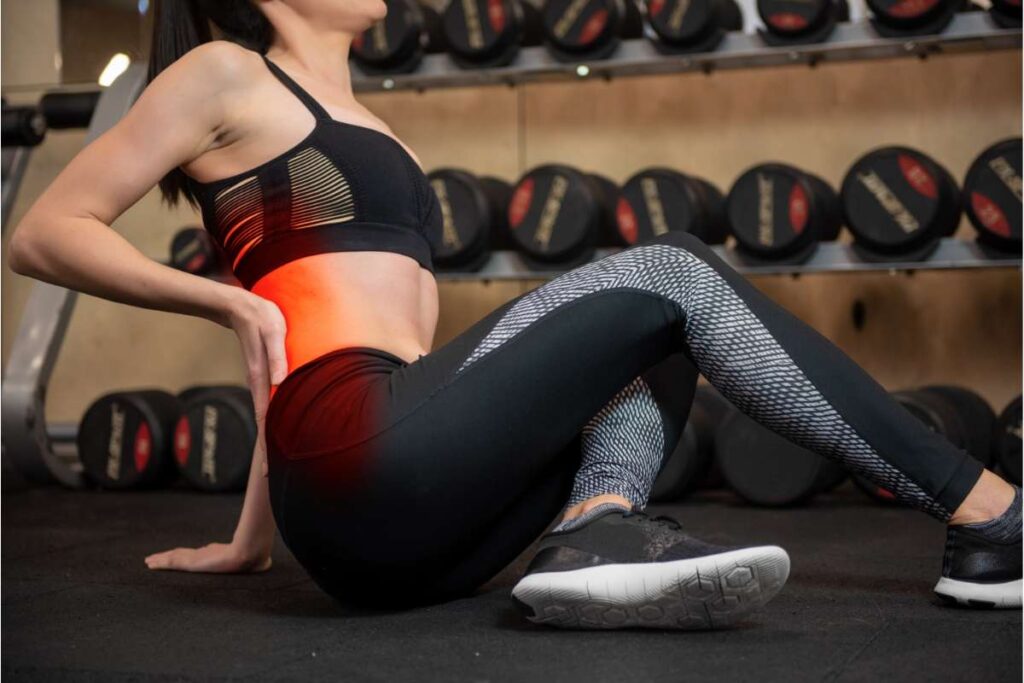
Training and building a stronger back is not only aesthetically beneficial, it is great for your functional health.
Having a weak back can result in poor function and chronic pain, among other things we’ll discuss right now.
Poor Function
Poor function is one of the biggest drawbacks when it comes to having weak back muscles.
Research shows us that when our back muscles are weak it makes it difficult to perform daily tasks such as sitting and lifting.
Basic moves such as sitting down, standing up, and lifting objects are more essential to everyday life than people realize – until their back is in bad shape.
Risk of Injury
When our back muscles are weak, the muscles supporting the back will adopt different mechanisms, altering our biomechanics.
The above mentioned study illustrates that this will form a compensation loop that will likely put pressure on other surrounding structures, which can result in pain and even injury.
Back Pain
When the muscles of our backs are weak, we may experience differing degrees of back pain, which can be incredibly difficult to live with.
Research shows that an increase in low back pain results in poor function, depressive symptoms, and an overall impaired quality of life.
This is likely due to the compensation patterns that we have formed due to weakness in our backs.
I see it all of the time. It sadly results in a cycle of dysfunction that creates pain, leading to great compensation, perpetuating the process.
Headaches
When the muscles of the back become weak, it may also lead to an increased number of headaches.
Studies have found an association between low back pain and tension headache disorders.
This is understandable as the spine and many of its muscles support our posture and keep us upright.
A good representation of this is upper cross syndrome.
Here, the muscles of the upper back are weak, leaving the muscles at the base of the skull to do much of the heavy lifting.
This overcompensation can lead to pain and loss of function for both the neck and back.
Best at Home Back Exercises To Include in Your Back Workout Program
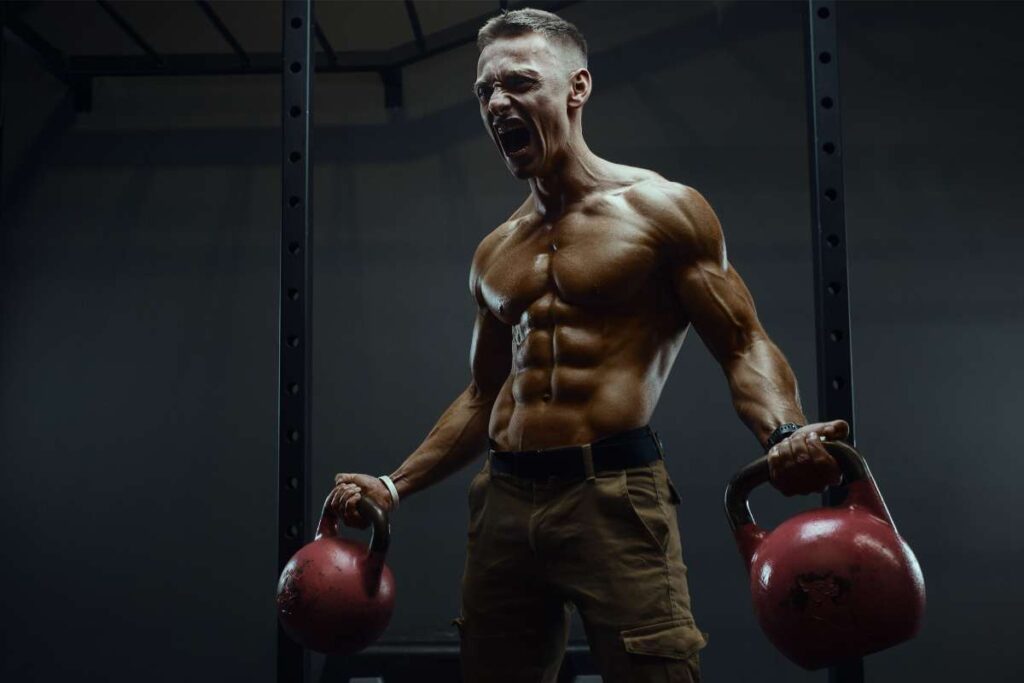
So, now that we have covered the awesome benefits of at home back workouts and why it is important to have a strong back, it’s time to get to the exercises.
Below are the 28 best back exercises to include in your back workout.
These exercises will be broken down into bodyweight exercises, dumbbells, kettlebells, and resistance bands to give you a full arsenal of all the right back exercises.
7 Best Bodyweight Back Exercises at Home
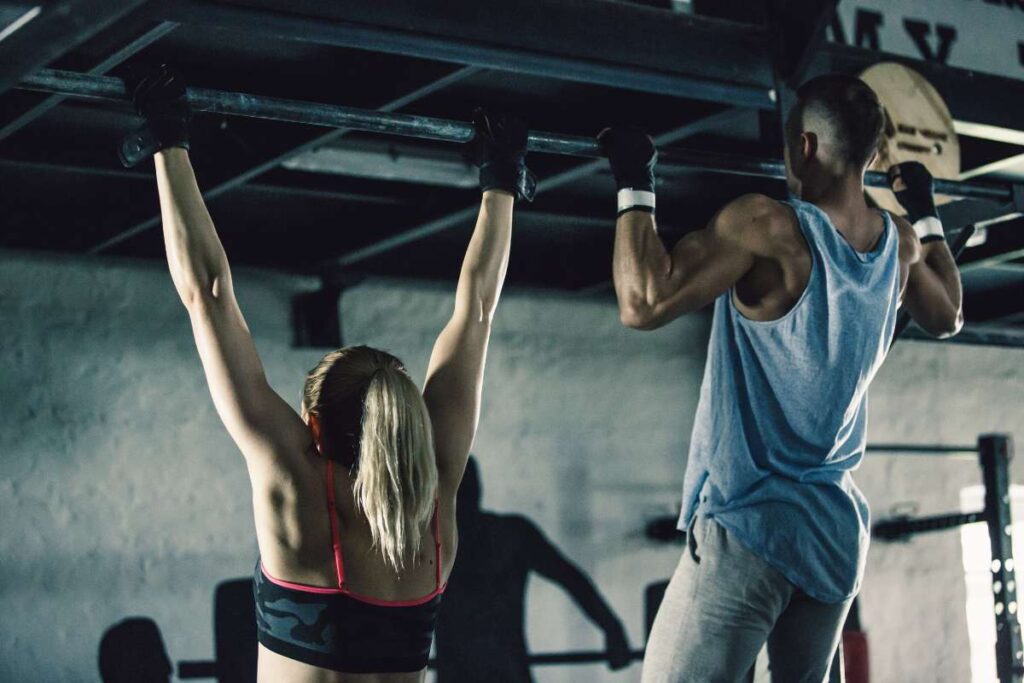
1. Plank
The plank is one of the most effective exercises for engaging the core and back muscles.
This is a great exercise to do prior to your lifts as it will help you activate your core before you get to your larger lifts.
Equipment Requirements
- Mat
- Floor Space
How To Perform Plank
- Kneel down and place your elbows on the mat.
- Position your feet hip-width apart with your weight on the balls.
- Lift your knees so that your torso is parallel with the floor.
- Hold for desired duration.
Benefits
- Engages core
- Activates erectors
Pro Tips
- Beginners should begin the plank on their knees and hold for shorter durations.
- When holding the plank, aim to keep hips parallel with the floor and focus on breathing.
2. Prone Back Extensions
The prone back extension is designed to target the glutes and lower back, and is great when done prior to your back workout.
This will ensure that your posterior chain is ready to go before hitting bigger lifts such as deadlifts and dumbbell rows.
Equipment Requirements
- Mat
- Floor Space
How To Perform Prone Back Extensions
- Lie face-down on the mat with your hands in a ‘W’ shape at shoulder height.
- Begin by tensing your glutes and lifting your chest and hands off the floor.
- Slowly lower the chest back down to the mat. Repeat.
Benefits
- Activates back muscles, priming them for bigger lifts
- Strengthens lower back
Pro Tips
- Perform smaller lifts and focus more on glute and lower back contraction rather than lifting higher.
- Keep arms in the ‘W’ position with thumbs pointing toward the ceiling. This will help your upper back engage during each lift.
3. Wall Scapula Holds
This standing shoulder blade squeeze allows you to target the muscles of the rear delts, rhombs, and lats by simply backing up to a wall and retracting your shoulder blades.
Yet again, it’s another great movement to train back on the go.
Equipment Requirements
- Wall
How To Perform Wall Scapula Holds
- Stand with your back against the wall with your elbows up high.
- Take a step forward with both feet.
- Begin by pushing your elbows into the wall and retracting the shoulder blade.
- Hold for one to two seconds, then release.
Benefits
- Engages upper back
- Can be done anywhere
Pro Tips
- Beginners should start closer to the wall and focus on pushing through the elbows and contracting the upper back muscles.
- As you progress, consider taking bigger steps away from the wall or perform the same movement using a mat on the floor.
4. Suspension Trainer Row
The suspension trainer row is an incredible exercise for targeting the back white engaging the entire body for support.
Equipment Requirements
- Trx/Suspension Trainer/Rings
How To Perform Suspension Trainer Rows
- Facing the wall, hold the suspension training handles so both your arms and bands are at full length.
- Gently pull the suspension trainer to create tension.
- Take two steps toward the wall and allow your body to tilt at a 70-degree angle.
- Begin the row by pulling your shoulder blades together, then pull yourself toward the anchor point.
- Row until your elbows are bent at 90 degrees, then lower until your arms are straight.
- Repeat.
Benefits
- Full body engagement
- Increase back muscle mass
Pro Tips
- Beginners should start with a slight incline and focus on technique. When comfortable, take steps toward the wall to increase resistance.
- Keep hips up for the duration of the set. This will engage the core and improve your ability to lift your bodyweight.
5. Inverted Row
The inverted row is one of the best ways to introduce pulling bodyweight exercises to your training.
Starting with the inverted row, you can gradually lower yourself and build up strength to perform chin-ups and pull-ups.
Equipment Requirements
- Barbell/Rings/Trx/Suspension Trainer
How To Perform Inverted Row
- Set up a barbell at waist height and sit directly beneath it.
- Reach over head and grab the bar using an overhand grip just wider than shoulder-width apart.
- Lift hips off the floor so that your weight is resting on your heels.
- Begin by pulling your chest up toward the barbell until your elbows are bent at 90 degrees.
- Then lower back to the starting position. Repeat.
Benefits
- Increase muscle mass
- Engage core
Pro Tips
- Keep hips up for the duration of the lift. This will help you lift your own body weight.
- When pulling yourself up, focus on pulling back with your elbows. This will improve contraction of your target muscles.
6. Chin-Ups
The chin-up is one of the best bodyweight exercises for building mass and strength.
By lifting your own bodyweight with your arms and back, your entire body must engage to stabilize, making it essential for anyone training back at home.
Equipment Requirements
- Pull-Up Bar
How To Perform Chin-Ups
- Standing directly below a chin-up bar, reach overhead and grab the bar with an underhand grip.
- Begin by pulling yourself up toward the bar until your collarbone meets the bar.
- Lower back to the starting position slowly and with control.
Benefits
- Builds strength
- Full-body activation
Pro Tips
- If you are struggling to reach the bar, consider using a step and hoisting yourself up.
- When pulling up, begin by pulling shoulder blades back and down and pulling with your elbows. This will increase contraction of your back muscles.
7. Pull-Ups
If you want to build a bigger back at home, pull-ups need to be at the top of your programming list.
Like chin-ups but with a wide or overhand grip, they can provide a greater challenge, which also means greater gains.
Equipment Requirements
- Pull-Up Bar
How To Perform Pull-Ups
- Stand below the pull-up bar and reach over your head with both hands. Grasp the bar with an overhand grip.
- Pull yourself up toward the bar until the pull-up bar meets your shoulders.
- Lower back down to the beginning position and repeat.
Benefits
- Increase upper body strength
- Targets all back muscles
Pro Tips
- Keep your legs straight for the duration of the set. This will help you lift your weight and minimize any unwanted movement.
- Focus on breathing, exhaling as you pull up and inhaling as you lower.
7 Best Dumbbell Back Exercises at Home
Related: 15 Awesome Dumbbell Back Exercises
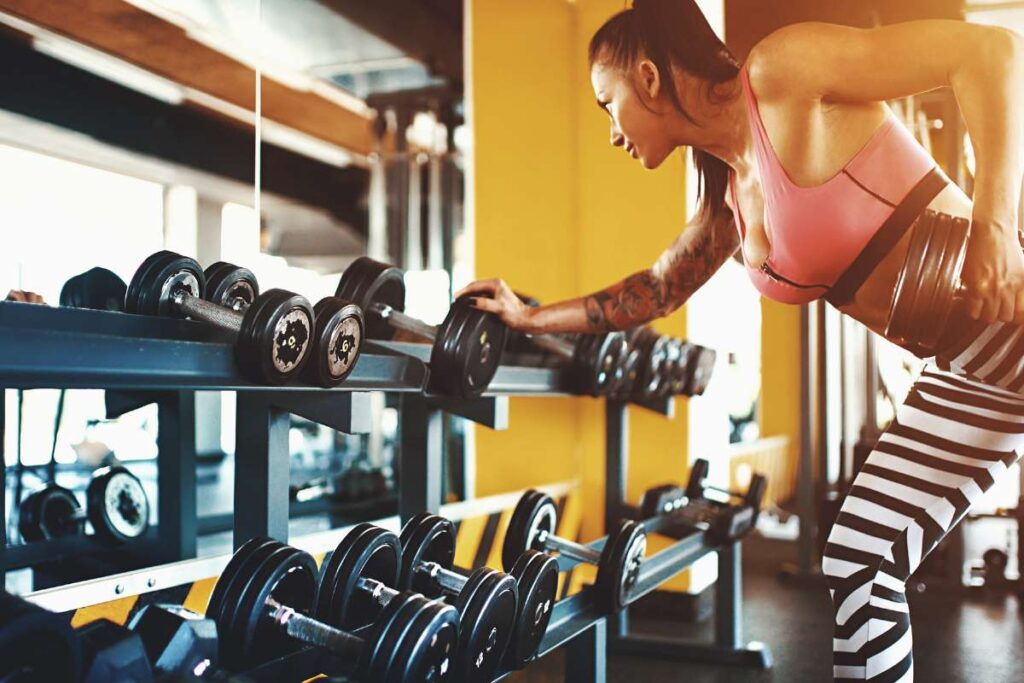
1. Dumbbell Deadlift
The dumbbell deadlift targets the back but benefits the entire body. With a dumbbell, you can gradually scale the exercise in difficulty and build serious mass.
Equipment Requirements
- Dumbbells
How To Perform Dumbbell Deadlifts
- Stand holding the dumbbells by your sides with a neutral grip.
- Place feet shoulder-width apart.
- Begin by leading back with your hips and leaning forward with your torso.
- Once the dumbbells pass knee level, begin to bend knees.
- Lift back up to the starting position. Repeat.
Benefits
- Builds strength and mass
- Targets back, hips, legs
Pro Tips
- Keep shoulder blades back and tucked down toward your hips for the duration of the movement. This will increase tension through the upper body.
- Focus on breathing, taking a deep breath before lowering and exhaling as you push back up. This will help your core remain rigid for each rep.
2. Dumbbell Bent-Over Row
Dumbbell bent-over rows are an old favorite, and a great inclusion to any back workout.
These are a must-have to create strength and mass, making an awesome exercise for your at-home dumbbell back workout.
Equipment Requirements
- Dumbbells
How To Perform the Dumbbell Bent-Over Row
- Stand holding a dumbbell in each hand in front of your legs.
- Lead back with hips and tilt torso forward at 70-degree angle.
- Allow your arms and the dumbbells to hang directly beneath shoulders.
- Begin by pulling shoulder blades back, rowing the dumbbell up toward your belly button.
- Once your elbows are bent at 90 degrees, lower back to the starting position. Repeat.
Benefits
- Engages hips, hamstrings, lower back
- Builds mass and strength
Pro Tips
- When performing the row, focus on pulling through your elbows. This will increase contraction of your back muscles.
- Start with a lighter weight and focus on keeping the same angle for the duration of the set.
3. Dumbbell Single-Arm Row
The dumbbell single-arm row is great for increasing lean muscle mass.
By performing this movement one side at a time, you will be able to hone in on technique and ensure you’re hitting your back with every rep.
Equipment Requirements
- Dumbbell
- Bench
How To Perform the Dumbbell Single-Arm Row
- Standing at the side, lean forward and place one hand on a bench.
- Using your free hand, grab the dumbbell with your arm out straight and your torso parallel with the floor.
- Begin by rowing the dumbbell toward your chest until your elbow is bent at 90 degrees.
- Lower it back to the starting position.
- Complete all reps for this side then switch.
Benefits
- Creates lean muscle mass
- Builds symmetry
Pro Tips
- When performing the row, pull back with your elbow and keep it tucked to your side. This will improve the contraction of your back.
- When rowing, pull back and down toward the hip. This will also improve contraction of your back muscles.
4. Dumbbell Renegade Row
The renegade row is an incredible exercise that will surely transform not just your back but your entire body.
This is due to the movement requiring you to hold the plank position while rowing, which will help you build serious core strength and a lean, cut back.
Equipment Requirements
- Dumbbells
How To Perform Renegade Rows
- Holding a dumbbell in each hand, set yourself up in the push-up position so that each hand rests on the dumbbells.
- Begin by rowing one dumbbell up toward the body until your elbow is bent at 90 degrees.
- Slowly lower the dumbbell back to the floor.
- Alternate hands for the duration of the set.
Benefits
- Increases mass
- Builds core strength and control
Pro Tips
- If you are new to the renegade row, start with a lighter weight and perform the movement on your knees. This will help you familiarize yourself with the movement pattern.
- If you are struggling with balance during your rows, space your feet wider apart. This will give a wider base to improve stability.
5. Dumbbell Wide Bent-Over Row
The dumbbell wide bent-over row is an excellent exercise for filling out your upper back during your at home dumbbell back workout.
By rowing with your elbows out wide, you target not only the upper back, but your rear delts, greatly improving your physique.
Equipment Requirements
- Dumbbell
How To Perform the Dumbbell Wide Bent-Over Row
- Stand in the upright position with a dumbbell in each hand.
- Unhinge the hips and lean the torso forward at 70 degrees, allowing your arms to hang.
- Begin by rowing the dumbbell up toward your chest with your elbows out to the sides.
- Row until your elbows are bent at 90 degrees, then lower back to the starting position. Repat.
Benefits
- Targets upper back and rear delts
- Increases definition
Pro Tips
- Perform this exercise with lighter weight and focus on contraction of the upper back and rear delts. This will help you target these fibers.
- When rowing, focus on pulling back with your elbows. This will help you contract your upper back and rear delts.
6. Dumbbell Kroc Row
The Kroc row is an absolute monster when it comes to building muscle and increasing strength.
By performing the movement in a braced half-standing position, you can really load up and push your back muscle to grow.
Equipment Requirements
- Dumbbell
- Seated Bench
How To Perform the Dumbbell Kroc Row
- Standing with a dumbbell in one hand, lean forward at the hips and grasp the bench with your free hand.
- Begin by rowing the dumbbell up toward your chest.
- Row until your elbow is at a 90 degree angle and then release back to the beginning position.
- Complete all reps and switch sides.
Benefits
- Increase strength
- Builds serious mass
Pro Tips
- At first, start with a lighter weight and focus on the contraction of your back muscles.
- Gradually increase weight and go heavy for your later sets while maintaining correct technique for massive growth.
7. Dumbbell Pullover (Floor)
The dumbbell pullover is one of the best upper-body exercises you can perform with a dumbbell.
While great for targeting the back, it also requires a great deal of chest and core strength to perform the movement, making it a must for any at home back workout.
Equipment Requirements
- Dumbbell
- Bench/Floor
How To Perform Dumbbell Pullovers (Floor)
- Lie down on your back and position your feet on the floor with your knees bent at 90 degrees.
- Grab one end of the dumbbell with both hands holding the top end.
- Position the dumbbell directly over your chest.
- Begin by gradually lowering the dumbbell back over your head and down toward the floor.
- Lower until the dumbbell almost reaches the floor, then lift back to the starting position. Repeat.
Benefits
- Targets lats, chest
- Increase mass
Pro Tips
- Beginners should start with a lighter weight and focus on physique as it can be difficult to get the hang of.
- When performing the lift, focus on pulling through the lats to maximize contraction.
7 Best Kettlebell Back Exercises at Home
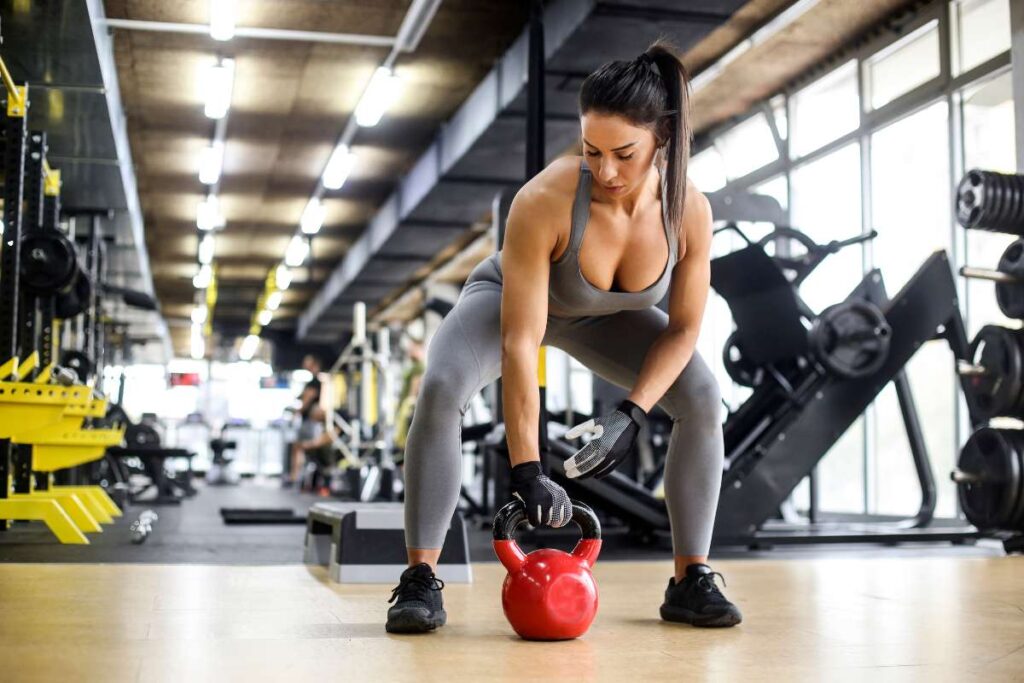
1. Kettlebell Deadlift
The kettlebell deadlift is one of the most effective (and comfortable) exercises to target and transform your back.
Equipment Requirements
- Kettlebell
How To Perform Kettlebell Deadlifts
- Stand holding a single kettlebell with both hands at the front of your body.
- Begin by leading back with the hips and leaning forward slightly as you lower down to the floor.
- Lower until the kettlebell makes contact with the floor.
- Push back up to the starting position. Repeat.
Benefits
- Targets back
- Builds mass and strength
Pro Tips
- To begin the movement, lead back back with your hips. This will help you lift using the hip hinge.
- Focus on breathing, inhaling before you lower and exhaling as you lift back up.
2. Kettlebell Pullover (Floor)
The kettlebell pullover is a brilliant exercise for targeting the back as well as toning the entire upper body.
Equipment Requirements
- Kettlebell
How To Perform Kettlebell Pullovers
- Lie down on your back and put your feet flat on the floor with knees bent.
- Grab a kettlebell with both hands and lift it directly over your chest with straight arms.
- Start by lowering over your head and toward the floor with straight arms.
- Lower until the kettlebell touches the floor, then lift back to the starting position. Repeat.
Benefits
- Target lats and chest
- Builds mass
Pro Tips
- Start with a lighter weight and focus on slowly lowering the kettlebell, squeezing through when lifting it back up.
- Focus on breathing and engaging the core. This will create stability through the body and help you lift the kettlebell back up off the floor.
3. Kettlebell Bent-Over Row
The kettlebell bent-over row is a simple and effective exercise for building strength and packing on mass.
Equipment Requirements
- Kettlebell
How To Perform the Kettlebell Bent-Over Row
- Stand holding a kettlebell in each hand.
- Unhinge at the hips and lean your torso forward at 70 degrees.
- Begin by rowing the kettlebells toward your body until your thumbs make contact with your ribcage.
- Lower back to the starting position. Repeat.
Benefits
- Engages lower back
- Build mass and strength
Pro Tips
- Setting up your position by unhinging at the hips will help you maintain a straight back for the duration of the set.
- When rowing, focus on pulling back with your elbows. This will increase contraction of your target muscles.
4. Kettlebell Gorilla Row
The kettlebell gorilla row is a great exercise for packing on lean muscle.
By resting the kettlebells on the floor with each rep, you can load up and lift with maximum effort.
Equipment Requirements
- Kettlebell
How To Perform Kettlebell Gorilla Rows
- Stand with a pair of kettlebells on the floor between your feet.
- Lead back with your hips as you lean forward 70 degrees and grasp the kettlebell handles.
- Begin by rowing one kettlebell up toward your chest until your elbow is bent at 90 degrees.
- Lower it back to the floor.
- Alternate sides for the duration of the set.
Benefits
- Increases strength
- Can load up weight
Pro Tips
- Position the kettlebell hands in a neutral grip. This will make them easier to lift.
- Row the kettlebells with a focus on pulling back your elbows. This will ensure you are working your back with every rep.
5. Kettlebell Single-Arm Row
The kettlebell single-arm row is excellent for building unilateral strength and mass.
Equipment Requirements
- Kettlebell
How To Perform Kettlebell Single-Arm Rows
- Stand in the upright position with a kettlebell in one hand.
- Lean forward at the hips 70 degrees.
- Begin by rowing the kettlebell up toward your body until the handle reaches your ribs.
- Lower back to the starting position.
- Complete all reps on this side, then switch.
Benefits
- Builds symmetry
- Increases strength
Pro Tips
- When performing the row, focus on pulling your shoulder blade back and squeezing your back muscles.
- Concentrate on breathing, exhaling as you row and inhaling as you lower.
6. Kettlebell Shrugs
Kettlebell shrugs are an awesome exercise for targeting the upper traps and filling out a strong, muscular back.
Equipment Requirements
- Kettlebells
How To Perform Kettlebell Shrugs
- Stand with a kettlebell in each hand.
- Start by shrugging your shoulders upward as high as they will go.
- Then, slowly lower back to the starting position and repeat.
Benefits
- Increases upper back mass
- Improves physique
Pro Tips
- Keep arms relaxed for the duration of the set.
- Focus on lifting the traps and squeezing the muscle equally on both sides.
7. Kettlebell Farmers’ Carry
The kettlebell farmers’ carry is designed to build carrying strength using a functional movement that we need everyday.
By carrying a heavy load, we must engage the entire body to support and move the weight from point to point, which makes for an incredible workout.
Equipment Requirements
- Kettlebells
How To Perform the Kettlebell Farmers’ Carry
- Stand holding a pair of kettlebells at your sides.
- Walk your chosen distance while keeping your chest up and core engaged.
Benefits
- Builds full-body strength
- Increase lifting capacity
Pro Tips
- Keep chest up and shoulder blades back and down when performing the carry. This will distribute the load throughout the entire upper body.
- When performing your set, focus on breathing and tensing your core. This will help improve your ability to lift the heavy load and target the abs.
7 Best Resistance Band Back Exercises at Home
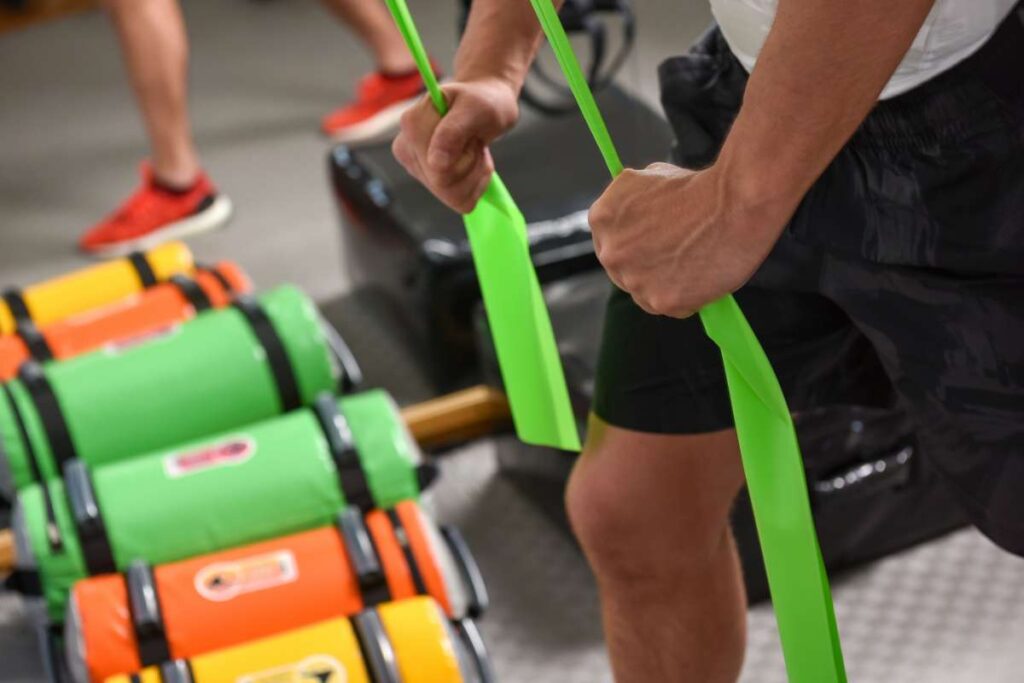
1. Resistance Band Row
The resistance band row is a great staple for any at home back workout. With a band, you can set the anchor point and get a great contraction with every rep.
Equipment Requirements
- Resistance Band
How To Perform Resistance Band Rows
- Attach the band to an anchor point at chest height.
- Grab the handles and take a step back so your arms are straight and there is tension on the band.
- Begin by rowing the band toward your belly button until your elbows are bent at 90 degrees.
- Release back to the starting position with control and repeat.
Benefits
- Targets lats and rhomboids
- Builds mass
Pro Tips
- Begin each row by retracting shoulder blades and then row. This will help you target your back muscles.
- When performing the row, focus on pulling back with your elbows to increase back contraction.
2. Resistance Band Wide Row
The resistance band wide row is an excellent movement to target the upper back and rear deltoids.
By performing this with your elbows up and away from the body, you can target the upper back to improve mass and definition.
Equipment Requirements
- Resistance Band
How To Perform Resistance Band Wide Rows
- Anchor the band at chest height and grab both handles.
- Take a step back so that your arms are straight and there is tension in the band.
- Begin by pulling shoulder blades back and rowing with your elbow 45 degrees, abducted from the body.
- Row until your elbows are bent at 90 degrees, then release back to the starting position. Repeat.
Benefits
- Improves physique
- Targets rear delts and upper back
Pro Tips
- Start with a lighter weight and focus on squeezing the upper back and rear delts.
- Concentrate on pulling back with elbows to maximize contraction.
3. Resistance Band Lat Pulldown
The resistance band lat pulldown is an excellent exercise for targeting the lats and building a broad, muscular upper back.
Equipment Requirements
- Resistance Band
How To Perform Resistance Band Lat Pulldowns
- Secure your band to an anchor point overhead and grab the handles.
- Kneel down on the floor with arms outstretched overhead and tension in the band.
- Begin by pulling shoulder blades back and down.
- Pull the handles down to your shoulders.
- Once at the bottom, release back to the starting position. Repeat.
Benefits
- Replicates lat pulldown
- Increases back mass
Pro Tips
- Begin each movement by depressing the shoulder blades. This will help you target the lats.
- Pull elbows back and down, this will increase lat contraction.
4. Resistance Band Bent-Over Row
The resistance band bent-over row is a great variation of the free weight version. It again targets the muscle of the back, but is a safe and inexpensive version due to the band’s light weight and low cost.
Equipment Requirements
How To Perform Resistance Band Bent-Over Rows
- Holding a handle in each hand, anchor the middle of the band under each foot.
- Leading back with the hips, lean forward 70 degrees.
- Begin by rowing the handles toward your belly button until your elbows are bent at 90 degrees.
- Release back to the starting position. Repeat.
Benefits
- Increase mass
- Inexpensive and safe
Pro Tips
- Anchor the band with a narrow stance to minimize resistance and gradually widen stance to increase resistance.
- When performing the row, focus on pulling back with elbows to increase lat activation.
5. Resistance Band Deadlift
The resistance band deadlift is great for targeting the back and entire body, and is excellent for building mass and strength.
Equipment Requirements
- Resistance Band
How To Perform Resistance Band Deadlifts
- Holding a handle on each hand, step onto the band with both feet shoulder-width apart.
- Begin by unhinging your hips and leaning forward slightly with the torso.
- Gradually lower your hips toward the floor.
- Lower until the handles just pass your knees, then drive back up to the upright position. Repeat.
Benefits
- Replicates deadlift movement
- Safe alternative to free weights
Pro Tips
- Choose your resistance based on the tension at the bottom of the lift. If at the bottom of the lift there is too much slack, consider widening your stance or increasing resistance.
- For each rep, lead back with the hips. This will help you keep a straight back for the duration of the set.
6. Resistance Band Face Pull
The resistance band face pull is an incredible exercise for building the upper back and strengthening your shoulders.
Equipment Requirements
- Resistance Band
How To Perform Resistance Band Face Pulls
- Secure your band to an anchor point at shoulder height.
- Holding a handle in each hand, take a step back so that your arms are outstretched and there is tension in the band.
- Begin the movement by retracting your shoulder blades.
- Then, pull the handles back until your hands reach ear level.
- Release back to the starting position. Repeat.
Benefits
- Targets upper back and rotator cuff
- Improves shoulder health
Pro Tips
- Initiate each movement by pulling shoulder blades together. This will improve upper back contraction.
- Start with a lighter weight and focus technique and contraction.
7. Resistance Band High Pull
The resistance band high pull is an excellent exercise that replicates the barbell version, targeting the upper back.
Equipment Requirements
- Closed Loop Resistance Band
How To Perform Resistance Band High Pulls
- Step onto the resistance band to anchor it and hold the other end at waist height.
- Begin by pulling the band up toward your chin.
- Once at the top, maintain control as you release back to the starting position. Repeat.
Benefits
- Targets upper back
- Improve physique
Pro Tips
- Keep chest up for the duration of the set. This will help you target the muscles of the upper back.
- Focus on breathing, exhaling as you pull up and inhaling as you release.
Best at Home Back Workout Program
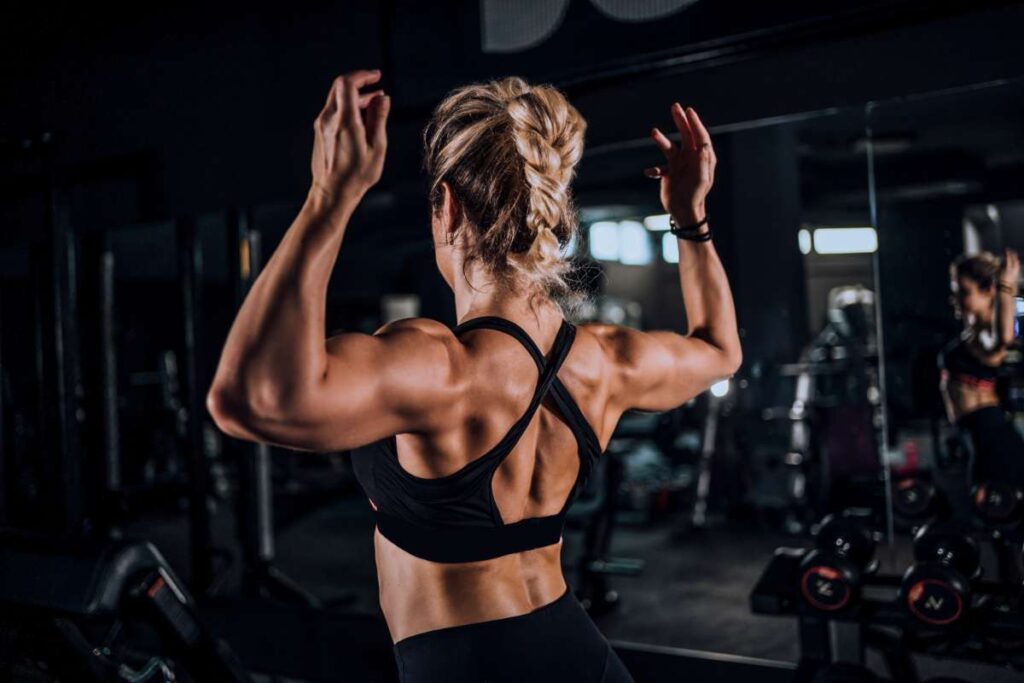
Now that we have our exercises, it’s time to combine them into your back-building routine.
Here are the best back workouts for bodyweight, dumbbells, kettlebells, and resistance bands.
Each program will come with a three-day split for beginners and a five-day split for advanced.
They will come with a weekly schedule as well as exercises, sets, reps, and rest to give you a full plan to build a shredded back.
Back Workout at Home Without Equipment (Bodyweight)
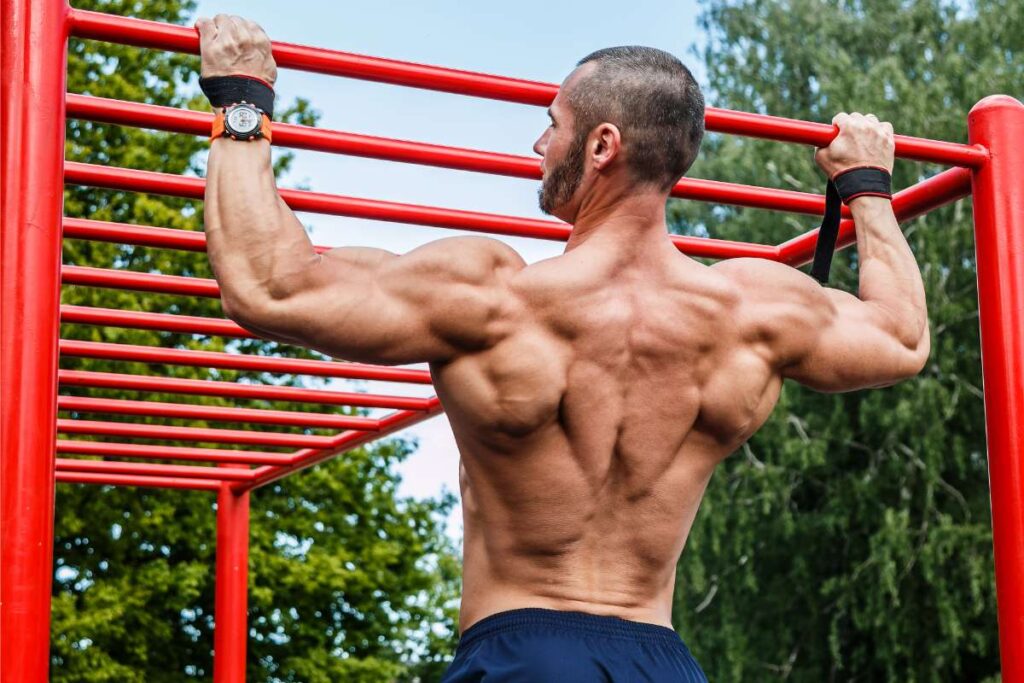
Beginner Weekly Schedule
| Mon | Tues | Wed | Thurs | Fri | Sat | Sun |
| Chest | Rest | Back | Rest | Legs | Rest | Rest |
Beginner Back Workout at Home Without Equipment (Bodyweight) (Duration 35 – 40 minutes)
| Exercise | Sets | Reps | Rest |
| Prone Back Extension | 3 | 10-15 | 30 secs |
| Plank | 3 | 20 secs | 30 secs |
| Wall Shoulder Blade Squeezes | 3 | 10 | 30-45 secs |
| Chin-Ups | 2 | 5 | 30-45 secs |
| Inverted Rows | 4 | 8-12 | 30-45 secs |
| Suspension Trainer Rows | 3 | 8-12 | 30-45 secs |
Advanced Weekly Schedule
| Mon | Tues | Wed | Thurs | Fri | Sat | Sun |
| Chest | Back | Legs | Rest | Chest | Back | Rest |
Advanced Back Workout at Home Without Equipment (Bodyweight) (Duration 40 – 50 minutes)
| Exercise | Sets | Reps | Rest |
| Prone Back Extension | 3 | 15 | 30 secs |
| Plank | 3 | 45 secs | 30 secs |
| Pull-Ups | 4 | 8 | 30-45 secs |
| Chin-Ups | 4 | 8 | 30-45 secs |
| Inverted Row | 4 | 8 | 30-45 secs |
| Suspension Trainer Row | 4 | 8 | 30-45 secs |
At Home Back Workout with Dumbbells
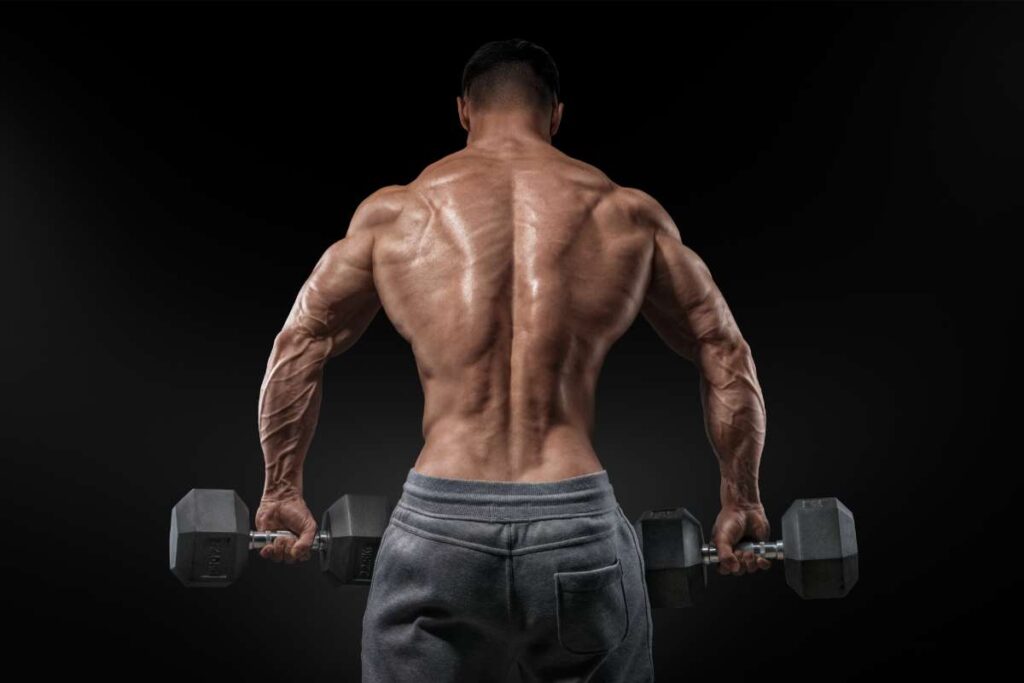
Beginner Weekly Schedule
| Mon | Tues | Wed | Thurs | Fri | Sat | Sun |
| Chest | Rest | Back | Rest | Legs | Rest | Rest |
Beginner At Home Back Workout with Dumbbells (Duration 30 – 35 minutes)
| Exercise | Sets | Reps | Rest |
| Dumbbell Deadlift | 3 | 10-12 | 45-60 secs |
| Dumbbell Pullover | 3 | 8-10 | 30-45 secs |
| Dumbbell Bent-Over Row | 3 | 8-10 | 30-45 secs |
| Dumbbell Wide Bent-Over Row | 3 | 10-12 | 30-45 secs |
| Dumbbell Single-Arm Rows | 3 | 10 | 30-45 secs |
Advanced Weekly Schedule
| Mon | Tues | Wed | Thurs | Fri | Sat | Sun |
| Chest | Back | Legs | Rest | Chest | Back | Rest |
Advanced At Home Back Workout with Dumbbells (Duration 30 – 35 minutes)
| Exercise | Sets | Reps | Rest |
| Dumbbell Deadlift | 4 | 8-10 | 45-60 secs |
| Dumbbell Renegade Row | 3 | 8 | 45-60 secs |
| Dumbbell Bent-Over Row | 4 | 8 | 30-45 secs |
| Dumbbell Dumbbell Single-Arm Row | 3 | 10-12 | 30-45 secs |
| Dumbbell Wide Row | 3 | 10-12 | 30-45 secs |
| Dumbbell Kroc Row | 4 | 8 | 45-60 secs |
| Dumbbell Pullover | 3 | 12 | 30-45 secs |
At Home Kettlebell Back Workout

Beginner Weekly Schedule
| Mon | Tues | Wed | Thurs | Fri | Sat | Sun |
| Chest | Rest | Back | Rest | Legs | Rest | Rest |
Beginner At Home Kettlebell Back Workout (Duration 30 – 35 minutes)
| Exercise | Sets | Reps | Rest |
| Kettlebell Deadlift | 3 | 8-12 | 45-60 secs |
| Kettlebell Pullover | 2 | 8 | 45-60 secs |
| Kettlebell Bent-Over Row | 3 | 8-10 | 30-45 secs |
| Kettlebell Single-Arm Row | 3 | 10-12 | 30-45 secs |
| Kettlebell Farmers’ Carry | 3 | 30-50m | 30-45 secs |
Advanced Weekly Schedule
| Mon | Tues | Wed | Thurs | Fri | Sat | Sun |
| Chest | Back | Legs | Rest | Chest | Back | Rest |
Advanced At Home Kettlebell Back Workout (Duration 50 – 60 minutes)
| Exercise | Sets | Reps | Rest |
| Kettlebell Bent-Over Row | 4 | 8 | 45-60 secs |
| Kettlebell Deadlift | 4 | 8 | 45-60 secs |
| Kettlebell Gorilla Row | 5 | 5 | 45-60 secs |
| Kettlebell Pullover | 3 | 8-12 | 30-45 secs |
| Kettlebell Single-Arm Row | 4 | 8 | 30-45 secs |
| Kettlebell Shrugs | 3 | 8-12 | 30-45 secs |
| Kettlebell Farmers’ Carry | 5 | 50m | 30-45 secs |
Back Workout at Home with Resistance Bands
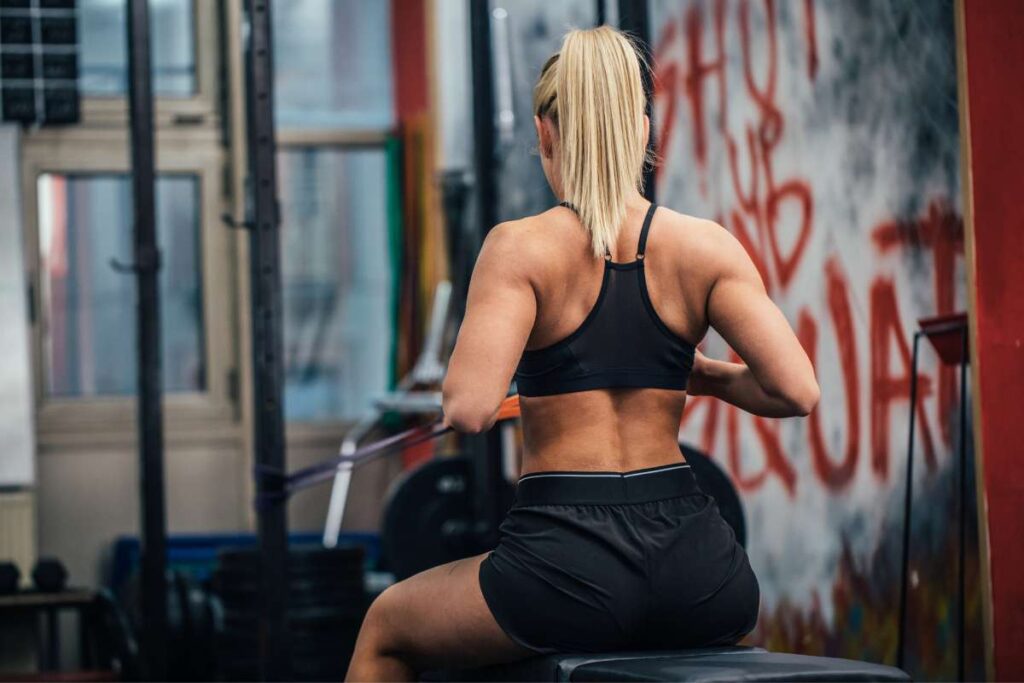
Beginner Weekly Schedule
| Mon | Tues | Wed | Thurs | Fri | Sat | Sun |
| Chest | Rest | Back | Rest | Legs | Rest | Rest |
Beginner Back Workout at Home With Resistance Bands
| Exercise | Sets | Reps | Rest |
| Resistance Band Deadlift | 3-4 | 8-10 | 45-60 secs |
| Resistance Band Bent-Over Row | 3 | 8-10 | 45-60 secs |
| Resistance Band Lat Pulldown | 3 | 12 | 30-45 secs |
| Resistance Band Row | 3 | 8-12 | 30-45 secs |
| Resistance Band Wide Row | 3 | 12 | 30-45 secs |
| Resistance Band Face Pull | 3 | 12 | 30-45 secs |
Advanced Weekly Schedule
| Mon | Tues | Wed | Thurs | Fri | Sat | Sun |
| Chest | Back | Legs | Rest | Chest | Back | Rest |
Advanced Back Workout at Home With Resistance Bands
| Exercise | Sets | Reps | Rest |
| Resistance Band Bent-Over Row | 2 | 10-12 | 30-45 secs |
| Resistance Band Face Pull | 2 | 10-12 | 30-45 secs |
| Resistance Band Deadlift | 4 | 8-12 | 45-60 secs |
| Resistance Band Lat Pulldown | 4 | 8-10 | 30-45 secs |
| Resistance Band Bent-Over Row | 3 | 10 | 30-45 secs |
| Resistance Band Wide Row | 3 | 12 | 30-45 secs |
| Resistance Band High Pull | 3 | 12 | 30-45 secs |
| Resistance Band Face Pull | 3 | 12-15 | 30-45 secs |
Tips for Training Your Back at Home
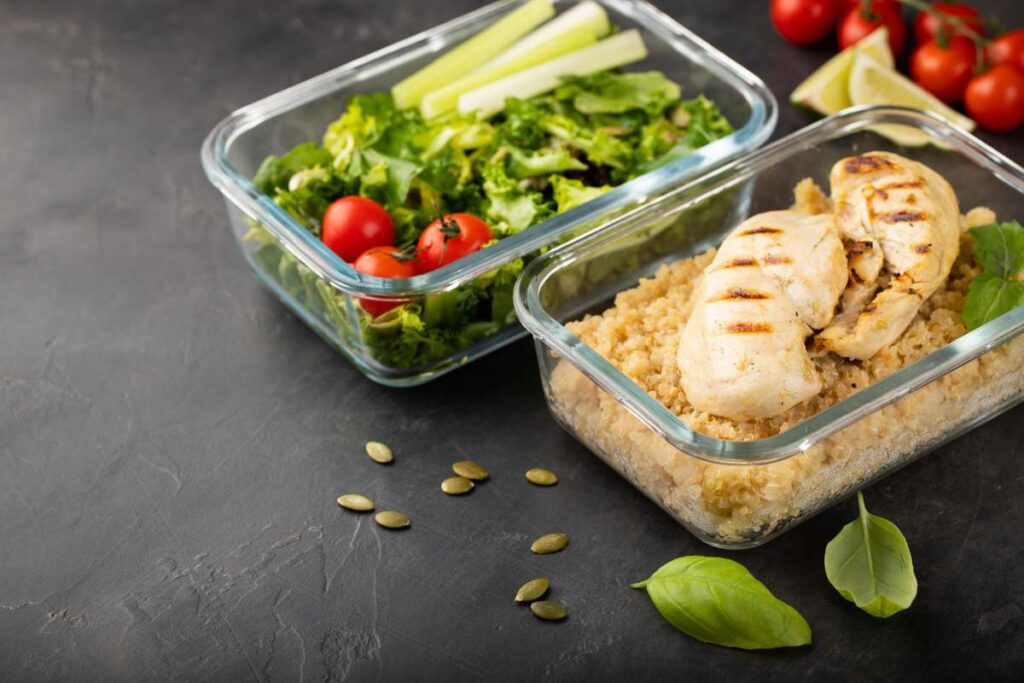
Getting a muscular back takes more than the correct exercise selection. It also requires correct nutrition and consistency.
Here are our professional tips to help you take your at home back workout to the next level and achieve amazing results.
Increase Protein Intake
If you are serious about transforming you will need the protein intake to match.
Science recommends a daily protein intake of 1.6g-2.2g of protein per kilogram of bodyweight for building lean muscle.
This can be done through eating protein rich foods such as lean meat, nuts, and seeds, as well as through protein supplements such as shakes and bars.
With more protein, you ensure that you are taking full control of your training and recovery to maximize those gains.
Track Calories and Macros
When it comes to building a bigger back, few things are more important than nailing your nutrition.
Tracking your calories and macronutrients ensures that you’re getting enough carbohydrates for energy, protein for building muscle, and fats to absorb essential nutrients.
To find out your exact calorie and macronutrient intake, use our advanced calorie and macronutrient calculator.
Here you can plug in your age, gender, height, weight and activity level, to get a precise calorie and macronutrient breakdown to conquer your goals.
Once you have this number, we also recommend entering them in a nutrition tracking app.
This will help you record all your meals and macros to help you build your way to a massive back.
Eat a Calorie Surplus
When we are setting out to build lean muscle, we need to eat a calorie surplus to provide us with enough energy to perform our workouts and build muscle.
Studies indicate that the daily calorie intake for men is 2,500 and 2,000 for women, but this varies depending on many factors.
To find out your exact intake use our calorie and macronutrient calculator. You’ll get an accurate reading for specific goals.
In general, a calorie increase of around 500-700/day may help add lean muscle to your frame.
Follow a Program
Chasing goals like building a bigger back takes more than just smashing back exercises week in and week out.
It takes careful planning and forward thinking to ensure you are taking measured steps toward those goals.
Following a program will not only help you clearly define your destination, it will help show you the steps it takes to get there.
This can be especially helpful when your program is dragging out and your lifts begin to plateau.
Having that program will help you take a step back and focus on the process so you can keep moving forward.
Progressively Overload
If you want a big back, you will need to progressively overload to make those muscles grow.
Research indicates that when we progressively overload with incremental increases to weight, sets, and reps, we gradually build bigger, stronger muscles.
A program finds you taking these principles into each workout, so you’re taking the right steps to building a bigger back at home.
Final Thoughts

Training your back at home is an incredible way to pack on size and transform your physique.
With dumbbells, kettlebells, bodyweight, and resistance bands, there is a huge variety of movements to stimulate incredible growth.
If you are considering performing an at home back workout just remember to eat a calorie surplus, progressively overload, and follow a program.
You will in time grow that broad, muscular back without setting foot in a gym.
So, are you currently performing at home back exercises or thinking about training at home? Which pieces of equipment do you think will best suit your training style?
Let us know in the comments.
Can you build back without equipment?
Yes, you can build your back without equipment using bodyweight exercises such as pull-ups and chin-ups.
Is it possible to build a back at home?
Yes, it is possible to build a back at home using bodyweight exercises, dumbbells, kettlebells and resistance bands. You still have to progressively overload the muscles, eat a protein-rich diet, and make sure you’re getting a caloric surplus.
How to workout back at home?
To work your back at home, use equipment such as dumbbells, kettlebells, and resistance bands to progressively overload your back muscle. This will provide the stimulus required to promote muscle hypertrophy.
How can I work out my back at home without equipment?
You can train your back at home by performing bodyweight exercises such as chin-ups, pull-ups, and inverted rows. These three exercises are some of the most effective for challenging your back muscles and stimulating growth.

